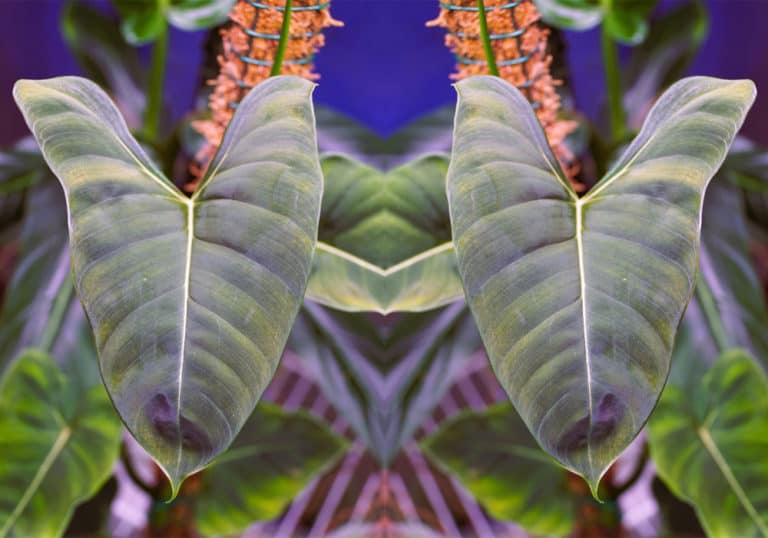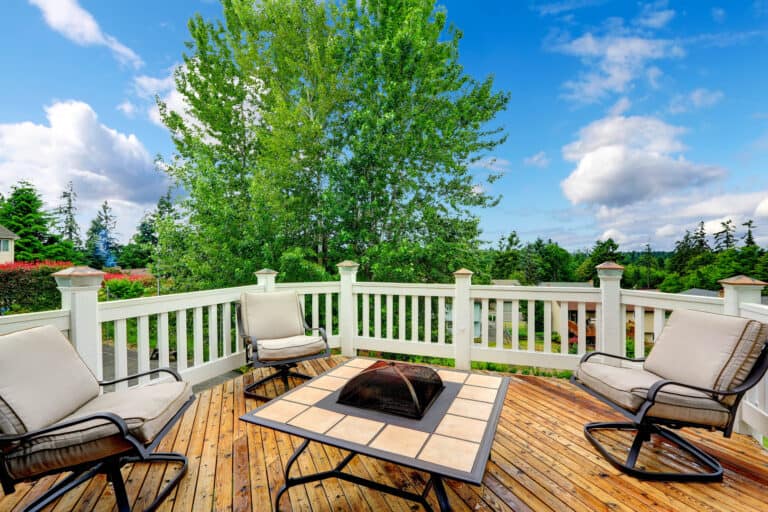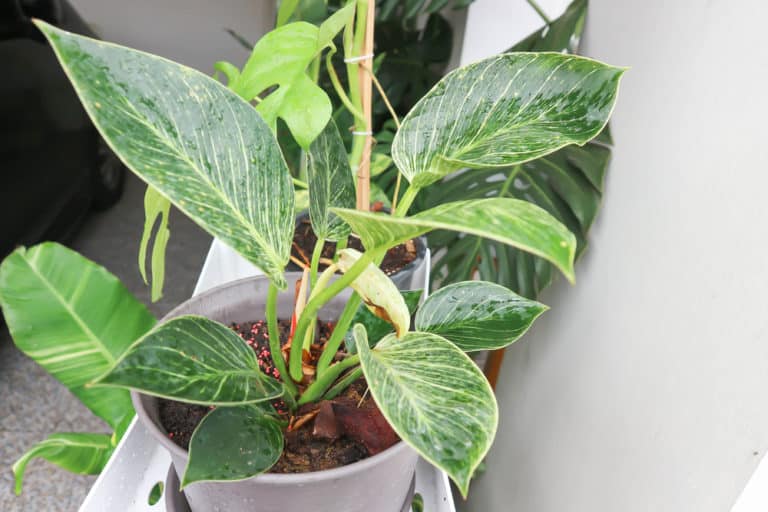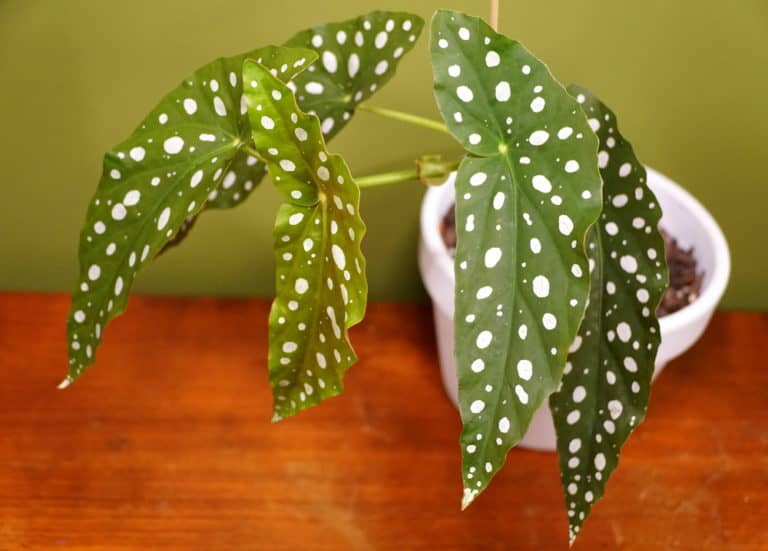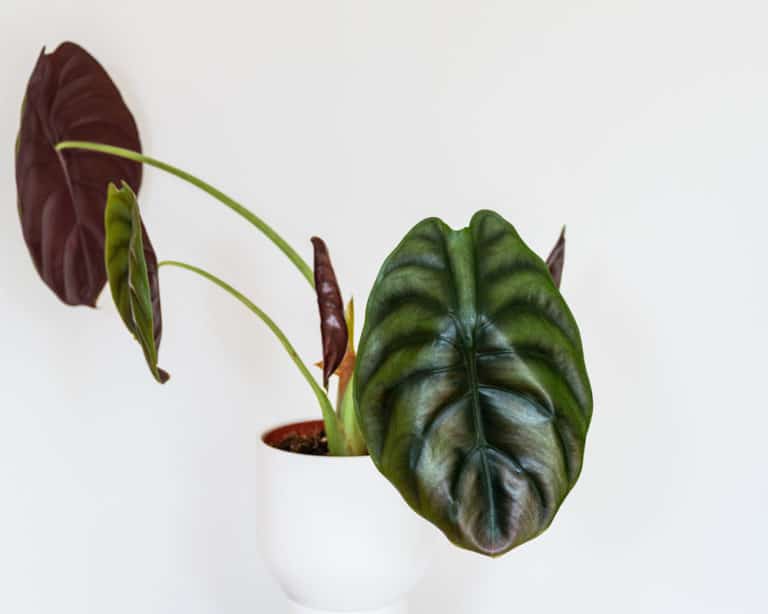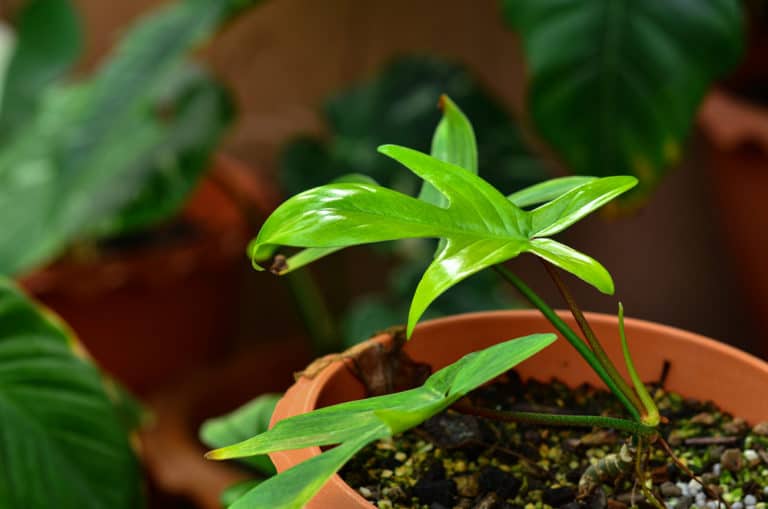Calathea Veitchiana ‘Medallion’ Care Guide (2024)
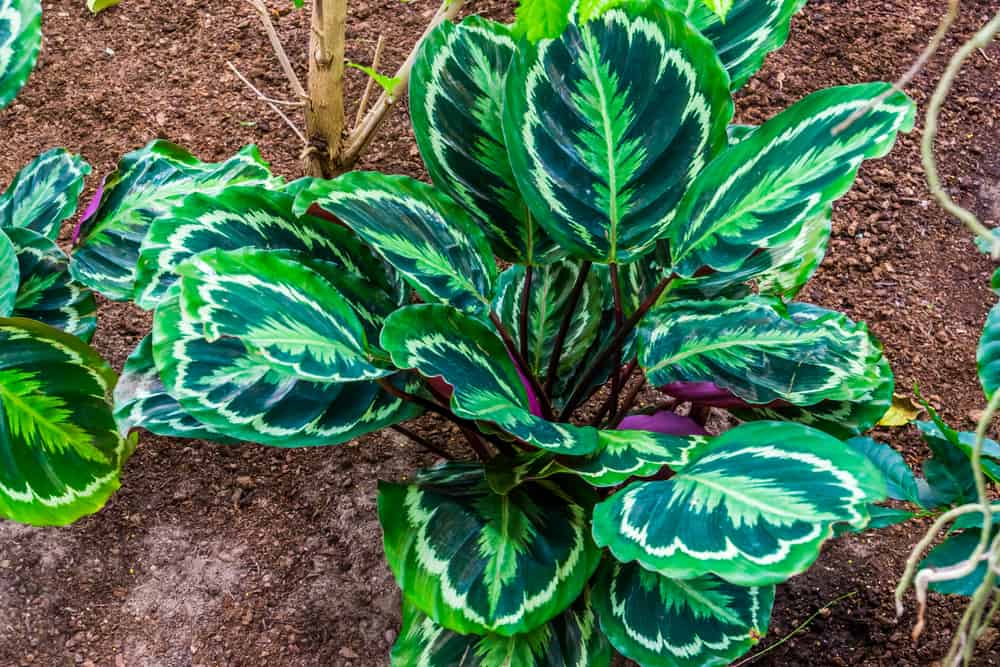
Calathea medallion is a gorgeous foliage plant that has happily adapted to life as a houseplant.
While it was originally classified as Calathea veitchiana, it was renamed Goeppertia veitchiana in recent years. However, it is still commonly referred to by its previous name.
While it can be a little fussy, its beautiful leaves and reasonable mature size make it a perfect plant for almost any location.
| Scientific Name | Calathea veitchiana ‘Medallion’ or Goeppertia veitchiana |
| Common Name | Calathea medallion |
| Light | Bright indirect sunlight |
| Watering | Water if the top 2 to 3 inches of soil are dry |
| Temperature | 65 to 80ºF (18 to 27ºC) |
| Hardiness Zone | 9 to 12 |
| Humidity | 50 to 60% |
| Soil Type | Rich, quick-draining, loamy |
| Soil pH | 6 (mildly acidic) |
| Fertilizing | A balanced feed once a month in spring and summer |
| Repotting | Every 2 years |
| Pruning | Only to remove dead foliage |
| Propagation | Division |
| Toxicity | Not toxic to humans and pets |
| Mature Size | 24 to 36 inches as a houseplant |
| Bloom Time | Rarely blooms |
What’s Unique About Calathea Medallion?
The Calathea medallion plant is native to Ecuador, where it grows at elevations from 400 to 1200 meters in the understory of tropical rainforests. It was first described by plant explorers in 1865.
However, it’s long been known by the indigenous peoples of the equatorial region of the Andes, who use the leaves to make baskets.
Calathea medallion plants are prized for their large, extravagantly patterned leaves that will brighten up any indoor space.
Growing Calathea medallion can be a bit challenging for a beginner, but once you’ve mastered its requirements, you can expect years of enjoying its beauty.
Calathea Medallion Care
Calathea veitchiana originates in the Andes in Ecuador, where it grows on the rainforest floor at fairly high elevations.
You should inform yourself about its native habitat to understand how best to provide Calathea medallion plant care.
Good medallion plant care means warm temperatures, high humidity, and bright but indirect light.
Light
Calathea veitchiana grows in the Andean rainforests, where rain falls frequently. Even though it’s on the equator where the sun’s rays are most direct, this region only averages 4 hours or fewer of sun per day.
As a result, Calathea medallion light requirements are for medium to bright indirect light, or between 2,500 to 10,000 lux.
You can best accommodate medallion plant light needs in a north or east-facing window, where they will not be exposed to the full sun in the afternoon.
However, if all you have is a south or west exposure, just find a spot in the room where the direct rays will not touch the delicate leaves.
Watering
In the rainforests of the Andes, it rains at least every other day, so Calathea veitchiana is acclimated to consistent soil moisture.
However, the soil drains the rainwater away fairly quickly, so when you water medallion plant you want to ensure that the soil never stays soaking wet.
The best approach for Calathea medallion watering is to check the soil every few days, and when the top few inches are dry, top up the soil moisture.
Calathea veitchiana’s watering needs are best met with rainwater. If you must use tap water, let it sit in an uncovered container overnight to let chemicals such as fluoride dissipate.
Temperature
Ecuador may lie right on the equator, but because the native habitat of Calathea veitchiana is at a higher elevation, temperatures aren’t that extreme.
The average daily high ranges from 79 to 82ºF (26 to 28ºC), and lows dip down to 61 to 65ºF (16 to 18ºC).
In your home, the Calathea medallion temperature range is from 65 to 80ºF (18 to 27ºC).
You should have no trouble supplying a satisfactory temperature for medallion plant.
If you want to give it a taste of really high temperatures, take it out to a shady patio or balcony for summer heat.
It’s not used to cool climates, though, and its temperature tolerance ceases below 55ºF (13ºC).
You must bring it in as summer ends, as it has no frost hardiness at all.
Humidity
The average humidity in Ecuador ranges between 70 and 80%.
As a consequence, your Calathea medallion humidity requirements are high, and this may be the single most challenging element of your Calathea veitchiana care.
The ideal humidity for medallion plant is 50 to 60%, with a preference for the high end of that range.
If you do not keep it at that humidity level, the leaves may get brown tips.
The easiest way to keep levels high enough for your Calathea veitchiana is by grouping your plants together to raise the humidity level. You can help them out by using a small humidifier.
Soil
In the Andean rainforests, the soil is spongy and loose, and full of decaying plant material.
Your Calathea medallion soil should be similar. It must drain well, while at the same time retaining an adequate amount of moisture.
The preferred pH level for medallion plant is 6, or mildly acidic.
You do not have to make your own soil for medallion, as an African Violet soil mix has all the essentials for your Calathea veitchiana.
However, you can also blend equal parts of peat moss, perlite, and potting soil. A handful of orchid bark or charcoal would improve drainage even more.
Fertilizer
The regular use of Calathea medallion fertilizer during its growing season will help ensure the vigorous growth of its lush leaves.
The best fertilizer for medallion plant is a liquid formulation with extra iron, with either a fertilizer ratio of 10-10-10 or 10-10-5.
Dilute the fertilizer to half its recommended strength, and pour over the soil surface shortly after you’ve watered.
Only feed your Calathea veitchiana in spring and summer, stopping during fall and winter when it is not actively growing.
If you start to notice salts building up on the soil surface, flush out the excess fertilizer by running a gentle stream of water through the soil for a few minutes.
Potting & Repotting
Calathea medallion repotting should be done every 2 years, or whenever you notice that it has become rootbound. If you can see roots, it’s time.
You may not need to increase the pot size when repotting medallion plant if you decrease its size by dividing the plant.
If you do need to move to a bigger pot, only go up one pot size. Too much extra soil will stay wet too long and increase the chance of disease.
Use a glazed or plastic pot to reduce the loss of soil moisture, and ensure that it has drainage holes.
Always use fresh potting soil, as the old soil may have become compacted and is not draining well, as well as harboring pathogens.
Pruning
Calathea medallion pruning is not recommended in general.
The only time you should remove leaves is when the oldest ones start to die off in the natural process. These will be the outermost leaves.
The only other reason for cutting medallion plant leaves is if they’ve developed brown edges or tips. Once you’ve solved the reason for those brown bits, don’t cut off the whole leaf; instead just trim away the browned edges with small, sharp scissors.
The trimmed leaf will continue to grow normally, and will look much better.
Always use sharp, sterilized tools for pruning your Calathea veitchiana.
Propagation
Calathea medallion propagation is usually done by dividing the roots of the existing plant, usually at the same time you’re repotting the mother plant.
To propagate medallion plant by division, pull the root ball out of its pot and carefully brush off as much soil as possible.
You should see where new plants have separated from the mother plant, although their roots will be intertwined.
Gently tug the small plantlets free, using a sharp, sterilized knife only if necessary.
Plant each new baby Calathea veitchiana in its own small pot, and keep them well-watered in a shady spot until they show signs of strong new growth.
Also, make sure to check out our in-depth Calathea musaica plant care guide.
Common Problems of Calathea Medallion
Most Calathea medallion problems are avoidable, as long as you pay close attention to its requirements and perform routine maintenance.
However, if problems with medallion plant do arise, you should be able to solve them without too much trouble.
The leaves will let you know if there’s something amiss, and then all you have to do is diagnose the cause.
Pests
Calathea medallion pests include most of the regular indoor plant culprits.
You should be able to keep bugs away from your medallion plant by wiping down the leaves every month with an insecticidal soap or neem oil solution. It’s always best to use an organic insecticide.
Spider mites spin their webs and leave yellow bumps. Thrips are tiny thin insects. For both, spray down the leaves in the shower or sink.
Fungus gnats are little black flies that love damp soil. Use yellow sticky traps and drench the soil with a mixture of hydrogen peroxide and water.
Mealybugs gather under the leaves in cottony masses. Use a cotton ball dipped in rubbing alcohol to kill them.
Diseases
Most Calathea medallion diseases can be prevented by careful watering practices. Never get the leaves wet, and always let excess water drain out of the pot.
Your medallion plant leaves may start to turn yellow, and the stems soften. If the roots have turned black with a bad smell, that’s root rot.
Cut out all affected parts and replant what’s left in fresh soil in a new pot.
Leaf spot can be caused by several different fungal or bacterial diseases, but the treatment is the same for most of them.
Move your diseased Calathea veitchiana away from all other plants, and remove all infected leaves and stems.
Improve the air circulation around the foliage, and observe it for a couple of weeks. In a severe case you will have to discard the plant.
Growing Problems
If your Calathea veitchiana has growing problems, curing your sick plant might be a simple matter of improving its growing conditions.
Brown edges on the leaves might indicate too much fertilizer usage, or using tap water with chlorine and fluoride. Trim off the edges and adjust your watering or feeding methods.
Curling leaves can mean low humidity, dry soil, or too much direct sun. Evaluate the soil moisture and location and make the required changes.
Brown tips are usually a sign that humidity levels are too low for this rainforest native. You may need to invest in a humidifier, as misting will not usually be enough.
Toxicity of Calathea Medallion
The medallion plant is not toxic to humans or animals at all.
This lack of toxicity makes it an ideal houseplant if you don’t want the risks associated with plants like philodendrons.
However, it’s never a good idea to let your pets and children have unfettered access to your plants.
For Humans
Because Calathea veitchiana is not toxic to humans, you do not need to have any concerns about your children having life-threatening reactions upon exposure to the plant.
However, you still should exercise caution when growing any houseplant.
In the first place, children can sometimes get a little too hands-on with plants, and the leaves of Calathea veitchiana are certainly very inviting. You don’t want your tropical beauty damaged.
Secondly, you are probably using fertilizers and insecticides on this and other plants. Even if these are organic, children should not be handling or ingesting them
And finally, many houseplants do have varying levels of toxicity and can pose a risk to young children. Since they won’t know which are ok and which aren’t, you should simply have a rule that all plants are off-limits.
For Pets
If your pets start eating your Calathea veitchiana leaves, they aren’t going to require a rushed and expensive trip to the veterinarian, so that’s good.
However, quite aside from the damage to your plant, you may not be happy with the after-effects of your cat or dog ingesting Calathea medallion foliage.
Canines and felines have evolved as carnivores, and they are much better at digesting meat than vegetables.
If they eat too much plant material, they may have a bout of vomiting and diarrhea as their gastrointestinal systems try to deal with it.
It’s best to keep your Calathea medallion somewhere out of their reach.
Calathea Medallion Appearance
The Calathea medallion appearance is lush and colorful, adding an exciting tropical look to wherever it is used.
The large, gorgeously colored leaves grow in profusion on the short, bushy plant, and will sometimes fold up slightly at night to display their brilliant underside.
Even though they very rarely bloom, the flowers will not be missed.
Foliage
The foliage of Calathea medallion looks like an impressionist painting.
Each leaf has varying shades of green, cream and silver that look like they’re brushed on in irregular bands radiating out from the center rib.
Underneath they are bright purple, creating a vibrant contrast. The thin stems are also a deep pink-purple.
Leaves emerge as a rolled up tube from the center of the plant. After they unfurl they can grow to a length of between 5 and 10 inches, in a rounded shape with smooth margins.
They have a leathery texture and a glossy surface. Wipe them down periodically to keep them looking their best.
Flowering
It is very rare to see a medallion plant flower on a Calathea medallion grown indoors as a potted plant, no matter how hard you try.
Calathea medallion flowering usually only occurs on plants grown outdoors year-round in tropical climates similar to its rainforest home.
However, you are not missing much by not having a blooming Calathea medallion plant growing in your home.
The light green star-shaped flowers that appear in summer are small and inconspicuous, and have no fragrance.
Compared to magnificent year-round display of the evergreen Calathea medallion leaves, the very slight chance of insignificant blooms is hardly worth making an effort for.
Size and Growth
You can expect the mature size of Calathea medallion to be between 2 and 3 feet, with about a 2 foot spread.
It has a moderate growth rate, but may take up to 10 years to reach its full size, depending on factors such as heat, light, and humidity.
Calathea medallion grows from rhizomes, with individual stems emerging from under the soil. New leaves emerge tightly furled, looking like purple tubes.
It does not require any staking to grow upright, but because it is very sensitive to light, you should rotate it a quarter turn once a week to keep it growing evenly.
Calathea Medallion Fragrance
You will not detect any Calathea medallion fragrance. Even the rarely seen flowers have no scent.
However, Calathea medallion plants are known to be good at purifying the air, removing toxic chemicals from your indoor environment.
You can also grow Calathea medallion even if you have a sensitivity to strong fragrances.
Even if you don’t have allergies, a strongly scented plant can be overwhelming in the constricted space of a small apartment.
And in public settings such as offices and nursing homes, fragrant plants often aren’t even permitted.
In those places, a non-toxic fragrance-free plant such as Calathea medallion is perfect.
Suggested Uses for Calathea Medallion
Because of its moderate size, non-toxic nature, and gorgeous foliage, there are many options for using Calathea medallion indoors.
If you have room in your bathroom, it won’t mind the lower light levels, and will love the extra humidity.
It’s also a perfect choice to fill in a rather shady corner in a living room where other plants might not thrive.
As either a stand-alone specimen plant, or as a part of a larger indoor garden, its brilliantly patterned leaves will make it a star.
Outdoors, a couple of Calathea medallion plants will go a long way to creating a tropical oasis on a shady patio or balcony.
FAQ
What is Calathea medallion?
The Calathea medallion plant is an evergreen tropical plant native to the rainforests in the Andes in Ecuador, where it grows on the forest floor.
How to identify Calathea medallion?
The Calathea medallion plant has large, rounded leaves 5 to 10 inches long, with feathery patterns in shades of green, cream and silver on top, and deep purple undersides.
How to care for Calathea medallion?
The Calathea medallion plant should be grown in loose, rich soil that is kept consistently moist. in medium indirect light in a warm and humid environment.
How to grow Calathea medallion indoors?
The Calathea medallion plant can be grown indoors as a potted plant out of the direct sun, with consistently warm temperatures and moderately high humidity.
How to grow Calathea medallion outdoors?
The Calathea medallion plant can be planted outdoors in climate zones 9 to 12, in a shady location with rich, well-draining soil that is kept moist.
How fast does Calathea medallion grow?
The Calathea medallion plant has a moderate growth rate, and may take up to 10 years to reach its full size when grown indoors as a potted plant.
How tall does Calathea medallion grow?
The Calathea medallion plant can grow to a size of 2 to 3 feet with a spread of 2 feet when grown indoors as a container plant.
How to make Calathea medallion grow faster?
The Calathea medallion plant will grow best when kept out of the full sun, in a warm location with moderate to high humidity with regular light feedings in spring and summer.
How to stake Calathea medallion?
Calathea medallion is not a vining plant, so it does not need to be staked to grow upright. However, it should be rotated regularly to ensure even growth.
How to pot Calathea medallion?
The Calathea medallion plant should be planted in loose, well-draining soil with plenty of organic matter, in a plastic or glazed pot with good drainage holes.
How to revive Calathea medallion?
If your Calathea medallion plant has dried out, you should soak the pot in water until it has absorbed all it can, and then let the excess water drain thoroughly.
Why is my Calathea medallion dying?
Your Calathea medallion plant may have a fungal or bacterial disease from poor watering practices. Cut out all the infected sections and replant it in fresh soil.
Why is my Calathea medallion drooping?
Your Calathea medallion plant’s soil is probably too dry or too wet. Either give it a good watering or repot it in fresh, loose soil.
How cold can Calathea medallion tolerate?
The Calathea medallion plant prefers temperatures between 65 to 80ºF (18 to 27ºC), starts to suffer damage at 55ºF (13ºC), and will be killed by frost.
How to get rid of pests on Calathea medallion?
The Calathea medallion plant can be kept free of pests with regular use of insecticidal soap or neem oil, either by spraying or wiping down the leaves.
Is Calathea medallion toxic to cats?
No, the Calathea medallion plant is not toxic to cats. However, they cannot easily digest plant material and may have a period of vomiting and diarrhea.
Is Calathea medallion toxic to dogs?
No, the Calathea medallion plant is not toxic to dogs. However, they are carnivores and their digestive systems may react to ingesting the foliage with vomiting and diarrhea.
Is Calathea medallion toxic to children?
No, the Calathea medallion plant is not toxic to children. However, if you use insecticides and fertilizers, they may have an adverse reaction to those substances.
Is Calathea medallion toxic to humans?
No, the Calathea medallion plant is not toxic to humans, so you do not need to take any precautions such as wearing gloves when handling the plants.
Does Calathea medallion have a scent?
Neither the Calathea medallion plant foliage nor the rare flowers have any scent, so they can be used in any setting where people with fragrance sensitivities may be exposed to them.

